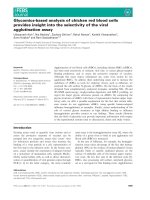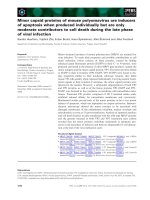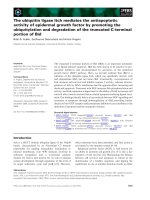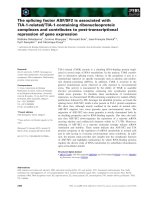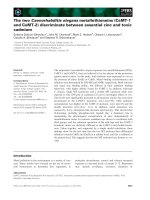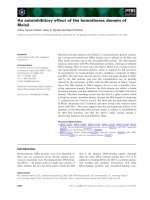Tài liệu Báo cáo khoa học: The kinetic properties of various R258 mutants of deacetoxycephalosporin C synthase doc
Bạn đang xem bản rút gọn của tài liệu. Xem và tải ngay bản đầy đủ của tài liệu tại đây (215.05 KB, 7 trang )
The kinetic properties of various R258 mutants
of deacetoxycephalosporin C synthase
Hwei-Jen Lee
1
, Young-Fung Dai
1
, Chia-Yang Shiau
2
, Christopher J. Schofield
3
and Matthew D. Lloyd
4
1
Department of Biochemistry, National Defense Medical Centre, Taipei, Taiwan, ROC;
2
Institute of Medical Science, National
Defense Medical Centre, Taipei, Taiwan, ROC;
3
The Oxford Centre for Molecular Sciences and Dyson Perrins Laboratory,
South Parks Road, Oxford, UK;
4
Department of Pharmacy and Pharmacology, University of Bath, Claverton Down, Bath, UK
Site-directed mutagenesis was used to investigate the control
of 2-oxoacid cosubstrate selectivity by deacetoxycephalo-
sporin C synthase. The wild-type enzyme has a requirement
for 2-oxoglutarate and cannot efficiently use hydrophobic
2-oxoacids (e.g. 2-oxohexanoic acid, 2-oxo-4-methyl-penta-
noic acid) as the cosubstrate. The following mutant enzymes
were produced: R258A, R258L, R258F, R258H and
R258K. All of the mutants have broadened cosubstrate
selectivity and were able to utilize hydrophobic 2-oxoacids.
The efficiency of 2-oxoglutarate utilization by all mutants
was decreased as compared to the wild-type enzyme, and
in some cases activity was abolished with the natural
cosubstrate.
Keywords: b-lactam biosynthesis; cephem; chemical cosub-
strate rescue; nonhaem iron(II) oxygenase; 2-oxoglutarate.
Deacetoxycephalosporin C synthase (DAOCS; Swiss-Prot
P18548) catalyses a key step in the cephamycin C biosyn-
thetic pathway in Streptomyces clavuligerus, i.e. the ring-
expansion of penicillin N (1) to deacetoxycephalosporin C
(DAOC, 2) [1–7] (Scheme 1). A sequence-related oxygenase,
deacetylcephalosporin C synthase (DACS; Swiss-Prot
42220), catalyses the subsequent hydroxylation of the exocy-
clic methyl group of (2) to give deacetylcephalosporin C
(DAC, 3). The DAC product is then converted by a series of
reactions, including 7-hydroxylation, into cephamycin C (4).
Oxidative reactions in this pathway are catalysed by
nonhaem iron(II) and 2-oxoglutarate (2-OG)-dependent
oxygenases [4]. Two of these enzymes, DAOCS and DACS,
are part of a sequence-related subgroup of enzymes [8],
which also include deacetoxy/deacetylcephalosporin C syn-
thase (the Cephalosporium acremonium bifunctional protein
catalysing the both ring-expansion and hydroxylation
reactions; Swiss-Prot P11935) and isopenicillin N synthase
(which is not a 2-OG-dependent oxygenase, but catalyses
the formation of the bicyclic penicillin nucleus; S. clavuli-
gerus enzyme Swiss-Prot P10621).
Understanding of the catalytic mechanism of DAOCS
[9–11] has been advanced by a combination of biochemical
and X-ray crystallographic studies [1,12–17]. These studies
have given insights into how the oxidation of 2-oxoglutarate
(the cosubstrate) and the penicillin substrate are coupled.
R258 and S260 are located in the 2-OG binding pocket and
bind the 5-carboxylate of the cosubstrate by electrostatic
interactions. Mutation of R258 to glutamine results in loss
of coupling between penicillin oxidation and 2-OG conver-
sion [17]. Moreover, the activity of the R258Q mutant could
be restored by the use of ÔunnaturalÕ 2-oxoacids (which are
not utilized by the wild-type enzyme) as cosubstrates
(Ôchemical cosubstrate rescueÕ) [17]. A similar change in
cosubstrate selectivity upon mutation of the analogous
arginine residue has been observed with the 2-OG-depend-
ent oxygenase, phytanoyl-CoA 2-hydroxylase [18,19]. This
paper reports the biochemical properties of other DAOCS
mutants, in which R258 has been replaced with uncharged
or positively charged amino acids.
Materials and methods
Materials
Chemicals were obtained from the Sigma-Aldrich Chemical
Co. or Merck and were of at least analytical grade or higher.
Reagents were also supplied by: Amersham Biosciences
(protein chromatography systems and columns); Bohringer-
Mannheim (ATP); MBI (1 kb and 100 bp DNA gel
markers); Bio-Rad (Kunkel mutagenesis reagents); New
England Bio-Laboratories (enzymes for molecular biology);
Novagen (pET vectors); Gibco/BRL (mutagenesis primers);
Phenomenex (HPLC columns).
Correspondence to H J. Lee, Department of Biochemistry, National
Defense Medical Centre, No. 161, Sec. 6, Minchuan East Road,
Neihu 114, Taipei, Taiwan, Republic of China.
Fax: + 886 2 87921544, Tel.: + 886 2 87910832,
E-mail: ; and
M. D. Lloyd, Department of Pharmacy and Pharmacology,
University of Bath, Claverton Down, Bath BA2 7AY.
Tel.: + 44 1225 386786,
E-mail:
Abbreviations: DACS, deacetylcephalosporin C synthase; DAOCS,
deacetoxycephalosporin C synthase; ESI-MS, electrospray ionization
mass spectrometry; G-7-ADCA, phenylacetyl-7-aminodeacetoxy
cephalosporanic acid; 2-OG, 2-oxoglutarate; 2-OH, 2-oxohexanoate;
2-OMP, 2-oxo-4-methyl-pentanoate.
(Received 14 November 2002, revised 29 January 2003,
accepted 4 February 2003)
Eur. J. Biochem. 270, 1301–1307 (2003) Ó FEBS 2003 doi:10.1046/j.1432-1033.2003.03500.x
Site-directed mutagenesis
Oligonucleotide-directed mutagenesis of R258 mutants was
performed using the Kunkel method [20,21]. Single-stranded
DNA in the pET24a plasmid (pHL1 [1]) containing the
DAOCS gene was used as a template for mutant produc-
tion, with the appropriate primers (Table 1). The presence
of the desired mutations was confirmed by automated DNA
sequencing (ABI 3100 sequencer).
Protein purification
Recombinant DAOCS and mutant proteins were expressed
in Escherichia coli BL21(DE3) as described previously at
37 °C after induction by 0.4 m
M
isopropyl thio-b-
D
-gal-
actoside. Wild-type and mutant enzymes were purified as
described [1,16] using a HiPrep 16/10 Q XL anion-exchange
column, which was eluted with 0.16–0.26
M
NaCl gradient.
Fractions (10 mL) containing DAOCS (as judged by SDS/
PAGE analyses) were further purified using a Sephacryl
S-100 column (XK26 column, 2.6 · 86 cm, 386 mL).
Protein oligomerization was assessed as reported [1] using
gel filtration chromatography with an S-200 10/30 column
equilibrated in gel filtration buffer. Secondary structures of
the purified wild-type and mutant proteins were compared
by circular dichroism analyses. The molecular masses of all
mutants were determined by ESI-MS (R258A: calculated
34470.6 Da, observed 34469 ± 5 Da; R258L: calculated
34512.6 Da, observed 34514 ± 5 Da; R258F: calculated
34546.7 Da; observed 34548 ± 4 Da; R258H: calculated
34536.6 Da, observed 34538 ± 5 Da; R258K: calculated
34527.7 Da, observed 34528 ± 6 Da).
Activity assays
Production of deacetoxycephems was assayed using the
reported HPLC or holed-plate assays [1] in a final volume of
100 lL. Reaction mixtures contained 50 m
M
Hepes/NaOH,
pH 7.5, 2 m
M
tris(carboxyethyl)phosphine, ascorbate,
FeSO
4
and 2-oxoacid, and 10 m
M
penicillin G or ampicillin
as ÔprimeÕ substrate. Approximately 0.05 mg of enzyme was
used in each assay. E. coli · 580 was used as the indicator
organism in the holed-plate assay [22]. HPLC separation of
the products was performed by isocratic elution with 25 m
M
ammonium bicarbonate in 16% (v/v) methanol on a
Hypersil C4 column (250 · 4.6 mm). Retention volumes
for the G-7-ADCA and cephalexin products (from penicillin
G and ampicillin, respectively) were 21.6 and 11.2 mL,
respectively. 2-OG conversion assays were conducted as
described previously [13], and were corrected for 2-OG
conversion in the absence of penicillin substrate. Apparent
kinetic parameters for the penicillin substrate (± SD) were
determined by HPLC assay [1]. Rates were determined in at
least triplicate for at least six concentrations of penicillin G
or ampicillin at a single defined concentration of the
2-oxoacid cosubstrate (2 m
M
).
Results and discussion
Purification and characterization of mutants
Wild-type DAOCS and all mutants were purified to at least
85% purity (as judged by SDS/PAGE and gel filtration
analyses) using a combination of anion-exchange and gel
filtration chromatographies. The DNA sequences of the
R258 mutants and the ESI-MS analyses showed that only
Table 1. Primer sequences for production of the R258 mutants of
DAOCS by the Kunkel method [20,21].
Mutation Primer sequence
R258K 5¢-ACTGGAGGTCTTGCTGCTGC-3¢
R258H 5¢-ACTGGAGGTGTGGCTGCTGC-3¢
R258A 5¢-ACTGGAGGTCGCGCTGCTGC-3¢
R258Q [17] 5¢-ACTGGAGGTCTGGCTGCTGC-3¢
R258L 5¢-ACTGGAGGTCAGGCTGCTGC-3¢
R258F 5¢-ACTGGAGGTGAAGCTGCTGC-3¢
Scheme 1. Conversion of penicillin N1 to cephamycin C4. 2-OG ¼ 2-oxo-glutarate; R ¼
D
-d-(a-aminoadipoyl)-; * methyl group incorporated into
cephem ring by DAOCS.
1302 H J. Lee et al.(Eur. J. Biochem. 270) Ó FEBS 2003
the desired mutations were present. Circular dichroism
analyses indicated that no gross changes in the secondary
structure of the mutant enzymes had occurred compared to
wild type DAOCS.
Activity assays for 2-oxoglutarate and penicillin
oxidation
Previously it has been reported that wild-type DAOCS is
only able to utilize a few 2-oxoacids as cosubstrates [17],
with the natural 2-oxoacid, 2-oxoglutarate, giving the
highest activity. Significant activity was also observed with
2-oxohexanedioate (2-oxoadipate) (64%) and 2-oxopro-
panoate (pyruvate) (5%). The R258Q mutation reduced
activity with 2-oxoglutarate and 2-oxopropanoate, but
allowed utilization of other 2-oxoacids.
Thus, all mutants were assayed for their ability to catalyse
2-OG conversion and penicillin oxidation in the presence of
various 2-oxoacids (Table 2, Scheme 2). Cephem produc-
tion (G-7-ADCA or cephalexin from penicillin G or
ampicillin, respectively) was monitored by HPLC and
holed-plate bioassays. The latter assay can give useful
confirmatory data, as this provides evidence that the enzyme
is producing a cephem antibiotic product. However, a linear
response is only observed over a limited range of product
concentrations and the response also depends on the
antibiotic potency of the cephem product [23]. Thus, the
results from the holed-plate assay should be interpreted with
care. The effect of mutations appears to be similar regardless
of whether the prime substrate was penicillin G or ampicillin.
Utilization of 2-oxoglutarate by the R258 mutants
The level of 2-OG conversion in the presence of a penicillin
substrate was reduced with all the R258 mutants (Table 2,
assay 1). The R258K mutant retained the highest levels
of activity in the presence of penicillin and ampicillin,
presumably due to maintenance of a charge interaction
between the lysine side-chain and 2-OG. The R258H
mutant retained little activity with 2-OG, which was
surprising in light of the results with the R258K mutant.
This probably arises due to the R258H side-chain being
deprotonated. The R258A, R258L and R258F mutants
almost completely abolished activity with 2-OG, presuma-
bly due to unfavourable charge/hydrophobic interactions
with the cosubstrate 5-carboxylate.
Penicillin G and ampicillin oxidation in the presence
of 2-oxoglutarate
All mutants displayed reduced penicillin conversion in the
presence of 2-OG (Table 2, assays 2 and 3). In some cases
Table 2. Activity comparison of wild type and R258 mutants in the presence of alternative 2-oxoacids using 10 m
M
penicillin G or 10 m
M
ampicillin as
substrate. Results are normalized to wild-type enzyme with 2-oxoglutarate as cosubstrate. The specific activities were 190 nmolÆmin
)1
Æmg
)1
for the
2-oxoglutarate conversion assay [7], 102 nmolÆmin
)1
Æmg
)1
for penicillin conversion by HPLC assay [1] and 72 nmolÆmin
)1
Æmg
)1
for the holed-plate
assay [1]. Standard deviations for these assays were approximately 15% and 10%, respectively, based on triplicate assays.
Assay Cosubstrate
DAOCS enzyme
Wild-type R258K R258H R258Q R258A R258L R258F
Penicillin G substrate (10 m
M
)
1. 2-OG conversion (CO
2
production) (a) 2-OG 100 66 6 30 19 26 < 5
2. HPLC assay (G-7-ADCA production) (a) 2-OG 100 28 12 18 < 2 16 9
(b) 2-OH < 2 23 23 46 53 74 57
(c) 2-OMP < 2 50 51 105 85 110 93
3. Holed-plate assay (G-7-ADCA production) (a) 2-OG 100 7 < 2 < 2 < 2 < 2 < 2
(b) 2-OH < 2 3 6 25 25 26 54
(c) 2-OMP < 2 7 24 72 49 76 69
Ampicillin substrate (10 m
M
)
1. 2-OG conversion (CO
2
production) (a) 2-OG 47 28 < 5 49 12 < 5 6
2. HPLC assay (cephalexin production) (a) 2-OG 52 10 4 9 6 3 5
(b) 2-OH < 2 11 38 38 36 45 56
(c) 2-OMP < 2 17 48 55 55 58 75
3. Holed-plate assay (cephalexin production) (a) 2-OG 41 7 < 2 < 2 < 2 < 2 < 2
(b) 2-OH < 2 10 15 37 31 41 58
(c) 2-OMP < 2 10 6 37 11 34 43
Scheme 2. Conversion of penicillin G to G-7-ADCA and ampicillin to
cephalexin by DAOCS.
Ó FEBS 2003 Co-substrate selectivity of DAOCS (Eur. J. Biochem. 270) 1303
reduced penicillin oxidation is simply a consequence of the
less efficient utilization of 2-OG as a cosubstrate. However,
reduced cephem production may also be due to uncoupling
of the two reactions, i.e. the stoichiometry is less than 1 : 1.
Comparison of the results for assays 1a and 2a imply that
the level of 2-OG conversion is greater than penicillin G
conversion by the R258A mutant, i.e. some uncoupling is
occurring. When ampicillin is used as the prime substrate
uncoupling is clearly present in all mutants except for
R258H, which does not catalyse conversion of 2-OG. The
difference in the levels of coupling between 2-OG and
penicillin G or ampicillin oxidation is probably a reflected in
the apparent K
m
values for these substrates.
The interpretation of these results is complicated because
the levels of uncoupling will be variable depending on the
mutant and the nature of the cosubstrate. Uncoupled
conversion has been shown to be responsible for auto-
oxidation of other oxygenases [24], and this may give rise to
enzyme inactivation. This uncoupling may be a consequence
of steric interactions between the penicillin substrate and the
hydrophobic side-chain of the coproduct (the carboxylic acid
that is analogous to succinate in the wild-type reaction), thus
causing misorientation of the penicillin to the high-energy
ferryl [Fe(IV)¼O/Fe(III)–O
Æ
] intermediate [16,25]. Crystal-
lographic analysis of DAOCS complexed with iron(II),
succinate and CO
2
demonstrated that the 4-carboxylate of
succinate may be bound by the side-chain of R160 or R162 in
the absence of any substrate [12]. This structure may reflect
catalysis during uncoupled reaction cycles (i.e. 2-OG
conversion in the absence of a penicillin substrate) in the
wild-type enzyme. Functional analysis of R160 and R162 by
site-directed mutagenesis suggests that these two residues
bind the nucleus of the penicillin substrate [16].
Rescue of enzyme activity of R258 mutants
by alternative cosubstrates
In the case of wild-type DAOCS, 2-OG cannot be replaced
by either 2-OH or 2-OMP (Table 2, assays 2b and 2c).
Because it was not possible to measure cosubstrate conver-
sion (assay 1) the possibility of uncoupled 2-oxoacid
conversion in the wild-type enzyme cannot be excluded.
All of the R258 mutants were able to catalyse cephem
production from both penicillin G and ampicillin in the
presence of aliphatic 2-oxoacids (2-OH and 2-OMP),
showing that broadening of cosubstrate selectivity occurs
when the side-chain of R258 is substituted by a positively
charged, polar [17] or hydrophobic side-chain.
Significant activity in the presence of hydrophobic
cosubstrates was unexpected for the R258K and R258H
mutants because the presence of a positive charge in the
active site would be expected to suppress cosubstrate
binding. In the case of the R258K mutant this may be
allowed because of disordering of the lysine side-chain, as
was previously observed for the R258Q mutant (Fig. 1) [17].
InthecaseoftheR258Hmutantitismorelikelythatthe
Fig. 1. Structure comparison of the active site of wild-type DAOCS (RCSB PDB accession no. 1rxg) complexed with iron (II) and 2-oxoglutarate and
the R258Q mutant (RCSB PDB accession no. 1hjf) complexed with iron (II) and 2-oxo-4-methyl-pentanoate (2-OMP). Wild-type residues are
represented by the red structure, mutant residues by the green structure. This figure was produced using
VIEWERPRO
( />viewer).
1304 H J. Lee et al.(Eur. J. Biochem. 270) Ó FEBS 2003
imidazole side-chain is predominately in an uncharged state
or that the positive charge is no longer proximal to the
cosubstrate side-chain. This result is consistent with loss of
activity in this mutant when 2-OG is used as the cosubstrate.
Higher levels of penicillin oxidation were observed when
2-OMP was used as a cosubstrate compared to 2-OH. The
results with the R258F mutant are particularly impressive,
as this single point mutation appears to almost completely
change the DAOCS cosubstrate selectivity from 2-OG to
hydrophobic cosubstrates.
Kinetic parameters of R258 mutants
Kinetic parameters for the mutants were determined using
the HPLC assay with either penicillin G or ampicillin as
substrates, in the presence of 2-OG, 2-OH or 2-OMP, as
appropriate. Due to the low activities of most mutants with
2-OG, only the R258K mutant was subjected to kinetic
analysis. Similar trends were observed for both mutants and
cosubstrates irrespective of whether penicillin G or ampi-
cillin was the ÔprimeÕ substrate (Tables 3 and 4), and the
results are consistent with those presented in Table 2.
However, care is required when interpreting these results for
several reasons. Firstly, only one concentration of cosub-
strate was used in each experiment and so apparent kinetic
parameters are reported. Secondly, the concentration of the
2-oxoglutarate cosubstrate has been shown to be a critical
factor in determining the activity of the wild-type enzyme,
which displays complex biphasic kinetics [26]. It is unclear if
a similar phenomenon is observed for rescuing cosubstrates
with mutant enzymes.
Mutants can be grouped into those that affect apparent
K
m
values, those that affect k
cat
values and those that
affect both K
m
and k
cat
values. In the case of the R258K
mutant with 2-OG, a modest decrease in k
cat
is observed
whilst K
m
is considerably increased for both penicillin
substrates.
When 2-OH is used as cosubstrate a decrease in k
cat
is
observed for the conversion of penicillin G in all mutants,
except for the R258F mutant. This decrease is absent when
Table 4. Kinetic parameters of R258 mutants using ampicillin as ÔprimeÕ substrate. Parameters were determined by HPLC assay with a fixed
concentration of 2 m
M
cosubstrate.
Enzyme
Fixed cosubstrate
(2 m
M
) k
cat
(s
)1
) K
m
(m
M
) k
cat
/K
m
(
M
)1
Æs
)1
)
WT 2-OG 0.014 ± 0.001 2.6 ± 0.24 5.4
R258K 2-OG 0.011 ± 0.002 13 ± 0.66 0.8
R258K 2-OH 0.009 ± 0.0009 24 ± 2.3 0.4
R258H 2-OH 0.007 ± 0.0005 4.2 ± 0.54 1.7
R258Q 2-OH 0.017 ± 0.003 6.6 ± 0.35 2.6
R258A 2-OH 0.008 ± 0.0009 4.2 ± 0.20 1.8
R258L 2-OH 0.012 ± 0.001 2.6 ± 0.50 4.6
R258F 2-OH 0.012 ± 0.002 1.9 ± 0.28 6.3
R258K 2-OMP 0.013 ± 0.002 15 ± 3.2 0.9
R258H 2-OMP 0.0053 ± 0.0002 4.1 ± 0.44 1.3
R258Q 2-OMP 0.014 ± 0.001 3.3 ± 0.44 4.2
R258A 2-OMP 0.011 ± 0.001 4.5 ± 0.43 2.4
R258L 2-OMP 0.0086 ± 0.00005 1.3 ± 0.01 6.6
R258F 2-OMP 0.011 ± 0.00005 0.79 ± 0.09 14
Table 3. Kinetic parameters of R258 mutants using penicillin G as substrate. Parameters were determined by the HPLC assay with a fixed
concentration of 2 m
M
cosubstrate.
Enzyme
Fixed cosubstrate
(2 m
M
) k
cat
(s
)1
) K
m
(m
M
) k
cat
/K
m
(
M
)1
Æs
)1
)
WT 2-OG 0.021 ± 0.002 1.1 ± 0.21 19
R258K 2-OG 0.010 ± 0.001 6.4 ± 0.75 1.6
R258K 2-OH 0.001 ± 0.0005 4.7 ± 0.37 2.1
R258H 2-OH 0.013 ± 0.0004 3.0 ± 0.29 4.3
R258Q 2-OH 0.010 ± 0.0001 0.79 ± 0.15 13
R258A 2-OH 0.013 ± 0.0003 0.79 ± 0.11 17
R258L 2-OH 0.019 ± 0.002 1.7 ± 0.14 11
R258F 2-OH 0.024 ± 0.0002 1.6 ± 0.01 15
R258K 2-OMP 0.020 ± 0.004 7.0 ± 0.85 2.9
R258H 2-OMP 0.014 ± 0.002 1.5 ± 0.04 9.3
R258Q 2-OMP 0.021 ± 0.001 1.5 ± 0.18 14
R258A 2-OMP 0.020 ± 0.002 1.8 ± 0.27 11
R258L 2-OMP 0.020 ± 0.002 1.2 ± 0.22 17
R258F 2-OMP 0.025 ± 0.004 0.84 ± 0.16 30
Ó FEBS 2003 Co-substrate selectivity of DAOCS (Eur. J. Biochem. 270) 1305
2-OMP is used as cosubstrate. The K
m
values for penicillins
are significantly increased in mutants with side-chains that
can be positively charged (R258K and R258H), whilst
mutants with hydrophobic side-chains, such as R258F,
appear to have similar or slightly lower K
m
values. Similar
trends were observed when ampicillin was used as the prime
substrate, although the magnitude of the changes in kinetic
parameters do not always correspond to those observed
with penicillin G. Notably, a modest increase in catalytic
efficiency (as judged by k
cat
/K
m
values) occurs for the
R258F mutant when 2-OMP is the cosubstrate with both
penicillin G and ampicillin.
Role of arginine residues in controlling cosubstrate
selectivity
The results highlight the essential nature of an arginine
residue in the 2-oxoglutarate binding site in DAOCS and
related oxygenases in controlling cosubstrate selectivity. The
key factors determining which alternative cosubstrates can
efficiently rescue oxygenase activity appear to be steric
constraints upon the size of the cosubstrate side-chain, and
the flexibility (or absence) of the substituted side-chain.
2-Oxoacids with up to six carbons or equivalent appear
to be efficient cosubstrates, whilst larger 2-oxoacids (e.g.
2-oxo-octanoate) are not [17,19]. Efficient coupling of
cosubstrate conversion with penicillin oxidation is also
crucial, and this also appears to be partially controlled by
the size of the cosubstrate side-chain.
Some oxygenases, e.g. prolyl 4-hydroxylase [27] appar-
ently have an active site lysine residue in place of arginine,
but still maintain control of cosubstrate binding. How this is
achieved is unclear, but it may be due to orientation of
several residue side-chains to accomplish the selective
charge–charge interaction. The presence of an additional
histidine residue in the prolyl 4-hydroxylase binding site
may be required to maintain the lysine side-chain in a
positively charged state. Thus, although the combination of
an arginine residue with a serine (or remote threonine [28])
residue appears to be an important mechanism for control-
ling cosubstrate selectivity in many oxygenases, it does not
appear to be universal.
Acknowledgements
We thank Dr R. T. Aplin for mass spectrometric analyses and Dr B.
Odell for NMR analyses. The Biotechnology and Biological Sciences
Research Council, Engineering and Physical Sciences Research Coun-
cil, Medical Research Council, the Wellcome Trust, the European
Union and the National Science Council, Republic of China are
thanked for financial assistance.
References
1. Lloyd, M.D., Lee, H J., Harlos, K., Zhang, Z.H., Baldwin, J.E.,
Schofield, C.J., Charnock, J.M., Garner, C.D., Hara, T., Ter-
wisscha van Scheltinga, A.C., Valega
˚
rd, K., Viklund, J.A.C.,
Hajdu, J., Andersson, I., Danielsson, A
˚
. & Bhikhabhai, R. (1999)
Studies on the active site of deacetoxycephalosporin C synthase.
J. Mol. Biol. 287, 943–960.
2. Schofield, C.J., Baldwin, J.E., Byford, M.F., Clifton, I.J., Hajdu, J.
& Roach, P.L. (1997) Proteins of the penicillin biosynthesis
pathway. Curr. Opin. Struct. Biol. 7, 857–864.
3. Baldwin, J.E. & Schofield, C.J. (1992) The Chemistry of
b-Lactams, Blackie Academic and Professional, London, UK.
4. Prescott, A.G. & Lloyd, M.D. (2000) The iron(II) and 2-oxoacid-
dependent dioxygenases and their role in metabolism. Nat. Prod.
Report 17, 367–383.
5. Jensen, S.E. (1986) Biosynthesis of cephalosporins. CRC Crit. Rev.
Biotechnol. 3, 277–301.
6. Martin, J.F. (1998) New aspects of genes and enzymes for b-
lactam antibiotic biosynthesis. Appl. Microbiol. Biotechn 50, 1–15.
7. Baldwin, J.E. & Abraham, E. (1988) The biosynthesis of peni-
cillins and cephalosporins. Nat. Prod. Report 5, 129–145.
8. Prescott, A.G. (1993) A dilemma of dioxygenases (or where bio-
chemistry and molecular biology fail to meet). J. Exp. Bot. 44,
849–861.
9. Townsend, C.A., Theis, A.B., Neese, A.S., Barrabee, E.B. &
Poland, D. (1985) Stereochemical fate of chiral-methyl valine in
the ring expansion of penicillin N to deacetoxycephalosporin C.
J. Am. Chem. Soc. 107, 4760–4767.
10. Pang, C.P., White, R.L., Abraham, E.P., Crout, D.H.G., Lutstorf,
M., Morgan, P.J. & Derome, A.E. (1984) Stereochemistry of the
incorporation of valine methyl groups into methylene groups in
cephalosporin C. Biochem. J. 222, 777–788.
11. Baldwin, J.E., Adlington, R.M., Kang, T.W., Lee, E. & Schofield,
C.J. (1988) The ring expansion of penicillins to cephems: a possible
biomimetic process. Tetrahedron 44, 5953–5957.
12. Lee, H J., Lloyd, M.D., Harlos, K., Clifton, I.J., Baldwin, J.E. &
Schofield, C.J. (2001) Kinetic and crystallographic studies on
deacetoxycephalosporin C synthase (DAOCS). J. Mol. Biol. 308,
937–948.
13. Lee, H J., Lloyd, M.D., Harlos, K. & Schofield, C.J. (2000) The
effect of cysteine mutations on the activity of recombinant dea-
cetoxycephalosporin C synthase from S. clavuligerus. Biochem.
Biophys. Res. Commun. 267, 445–448.
14. Lee, H J., Schofield, C.J. & Lloyd, M.D. (2002) Active site
mutations of recombinant deacetoxycephalosporin C synthase.
Biochem. Biophys. Res. Commun. 292, 66–70.
15. Valega
˚
rd, K., Terwisscha van Scheltinga, A.C., Lloyd, M.D.,
Hara, T., Ramaswamy, S., Perrakis, A., Thompson, A., Lee,
H J., Baldwin, J.E., Schofield, C.J., Hajdu, J. & Andersson,
I. (1998) Structure of a cephalosporin synthase. Nature 394,
805–809.
16. Lipscomb, S.J., Lee, H J., Mukherji, M., Baldwin, J.E., Schofield,
C.J. & Lloyd, M.D. (2002) The role of arginine residues in sub-
strate binding and catalysis by deacetoxycephalosporin C syn-
thase. Eur. J. Biochem. 269, 2735–2739.
17. Lee, H J., Lloyd, M.D., Clifton, I.J., Harlos, K., Dubus, A.,
Baldwin,J.E.,Frere,J M.&Schofield,C.J.(2001)Probingthe
cosubstrate selectivity of deacetoxycephalosporin C synthase: The
role of arginine-258. J. Biol. Chem. 276, 18290–18295.
18. Mukherji, M., Chien, W., Kershaw, N.J., Clifton, I.J., Schofield,
C.J., Wierzbicki, A.S. & Lloyd, M.D. (2001) Structure-function
analysis of phytanoyl-CoA 2-hydroxylase mutations causing
Refsum’s Disease. Hum. Mol. Genet. 10, 1971–1982.
19. Mukherji, M., Kershaw, N.J., MacKinnon, C.H., Clifton, I.J.,
Schofield, C.J., Wierzbicki, A.S. & Lloyd, M.D. (2001) ÔChemical
co-substrate rescueÕ of phytanoyl-CoA 2-hydroxylase mutants
causing Refsum’s Disease. J. Chem. Soc. Chem. Commun., 972–
973.
20. Kunkel, T.A. (1985) Rapid and efficient site-specific mutagenesis
without phenotypic selection. Proc. Natl Acad. Sci. USA 82, 488–
492.
21. Kunkel, T.A., Roberts, J.D. & Zakour, R.A. (1987) Rapid and
efficient site-specific mutagenesis without phenotypic selection.
Methods Enzymol. 154, 367–382.
22. Baldwin, J.E., Adlington, R.M., Coates, J.B., Crabbe, M.J.C.,
Crouch, N.P., Keeping, J.W., Knight, G.C., Schofield, C.J., Ting,
1306 H J. Lee et al.(Eur. J. Biochem. 270) Ó FEBS 2003
H.H., Vallejo, C.A., Thorniley, M. & Abraham, E.P. (1987)
Purification and initial characterization of an enzyme with dea-
cetoxycephalosporin C synthetase and hydroxylase activities.
Biochem. J. 245, 831–841.
23. Shibata, N., Lloyd, M.D., Baldwin, J.E. & Schofield, C.J. (1996)
Adipoyl-6-APA is a substrate for deacetoxycephalosporin C syn-
thase (DAOCS). Bioorg.Med.Chem.Lett.6, 1579–1584.
24. Liu, A., Ho, R.Y.N., Que, L., Ryle, M.J., Phinney, B.S. & Hau-
singer, R.P. (2001) Alternative reactivity of an a-ketoglutarate-
dependent iron (II) oxygenase: enzyme self hydroxylation. J. Am.
Chem. Soc. 123, 5126–5127.
25. Hamilton, C.S., Yasuhara, A., Baldwin, J.E., Lloyd, M.D. &
Rutledge, P.J. (2001) Contrasting fates for 6-a-methylpenicillin N
upon oxidation by deacetoxycephalosporin C synthase (DAOCS)
and deacetoxy/deacetylcephalosporin C synthase (DAOC/
DACS). Bioorg. Med. Chem. Lett. 11, 2511–2514.
26. Dubus, A., Lloyd, M.D., Lee, H J., Schofield, C.J., Baldwin,
J.E. & Frere, J M. (2001) Substrate selectivity studies on
deacetoxycephalosporin C synthase using a direct spectro-
photometric assay. Cellular and Molecular Life Sciences 58, 835–
843.
27. Myllyharju, J. & Kivirikko, K.I. (1997) Characterization of the
iron and 2-oxoglutarate-binding sites of prolyl 4-hydroxylase.
EMBO J. 16, 1173–1180.
28. Zhang,Z H.,Ren,J.,Stammers,D.K.,Baldwin,J.E.,Harlos,K.
& Schofield, C.J. (2000) Structural origins of the selectivity of the
trifunctional oxygenase clavaminic acid synthase. Nat. Struct.
Biol. 7, 127–133.
Ó FEBS 2003 Co-substrate selectivity of DAOCS (Eur. J. Biochem. 270) 1307

